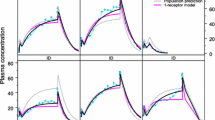Summary
In this paper an alternative approach to nonlinear pharmacokinetic modelling has been developed from first principles. This “Unsteady Model” is able to describe the situation whereby one or more independent drugs and their metabolites compete for free attachment sites in liver, tissue, red blood cells etc. The Unsteady model collapses to well-known existing models viz.: Michaelis-Menten, Langmuir tissue binding and the linear compartment models, under certain well-defined, limiting conditions. The Unsteady model and its collapse to existing models is derived mathematically and illustrated with simulations. For several reasons the Unsteady model would appear to have many advantages and wide application.
Similar content being viewed by others
References
Ashley JJ, Levy G (1972) Inhibition of diphenylhydantoin elimination by its major metabolite. Res Commun Chem Pathol Pharmacol 4: 297–306
Box MJ (1965) A new method of constrained optimization and a comparison with other methods. Computer J 8: 42–52
Davis RH (1972) Metabolite distribution in cells. Science 178: 835–840
Dayton PG, Cu cinell SA, Weiss M, Perel JM (1967) Dose-dependence of drug plasma level decline in dogs. J Pharmacol Exp Ther 158: 305–316
Eadie MJ (1976) Plasma level monitoring of anticonvulsants. Clin Pharmacokinet 1: 52–66
Fletcher R, Powell MJD (1963) A rapidly convergent descent method for minimization. Computer J 6: 163–168
Jähnchen E, Levy G (1972) Inhibition of phenylbutazone elimination by its metabolite, oxyphenbutazone. Proc Soc Exp Biol Med 141: 963–965
Kruger-Thiemer E (1968) Nonlinear dose-concentration relationships. Farmaco 23: 717–756
Levy G, Ashley JJ (1973) Effect of an inhibitor of glucuronide formation on the elimination kinetics of diphenylhydantoin in rats. J Pharm Sci 62: 161–162
Marquardt DM (1963) An algorithm for least-squares estimation of nonlinear parameters. J Soc Indust Appl Math 11: 431–441
Nelder JA, Mead R (1964) A simplex method for function minimization. Computer J 7: 308–313
O'Reilly RA, Aggeler PM, Leong LS (1964) Studies on the coumarin anticoagulant drugs: A comparison of the pharmacodynamics of dicoumarol and warfarin in man. Thromb Diath Haemorrh 11: 1–22
Perrier D, Ashley JJ, Levy G (1973) Effect of product inhibition on kinetics of drug elimination. J Pharmacol Biopharm 1: 231–242
Pritchard JF, Schneck DW, Hayes AH Jr (1980) The inhibition of rat hepatic microsomal propranolol metabolism by a covalently bound reactive metabolite. Res Commun Chem Pathol Pharmacol 27: 211–222
Remmer H (1972) Der Einfluß des Stoffwechsels von Arzneimitteln auf ihre Wirkungsstärke und Wirkungsdauer. Arzneim-Forsch 22:292–296
Sedman AJ, Wagner JG (1976) CSTRIP, a fortran IV computer program for obtaining initial polyexponential parameter estimates. J Pharm Sci 65: 1006
Tsuchiya T, Levy G (1972) Relationship between dose and plateau levels of drugs eliminated by parallel first-order and capacity-limited kinetics. J Pharm Sci 61: 541–544
Wagner JG (1971) In: Biopharmaceutics and relevant pharmacokinetics. Hamilton Press, Hamilton, Illinois, pp 302–317
Wagner JG (1977) Time to reach steady state and prediction of steady-state concentrations for drugs obeying Michaelis-Menten elimination kinetics. J Pharmacokinet Biopharm 5: 533–557
Author information
Authors and Affiliations
Rights and permissions
About this article
Cite this article
Smith, M.T., Smith, T.C. The unsteady model. Eur J Clin Pharmacol 20, 387–398 (1981). https://doi.org/10.1007/BF00615410
Received:
Revised:
Accepted:
Issue Date:
DOI: https://doi.org/10.1007/BF00615410




